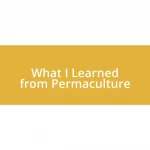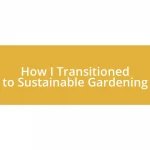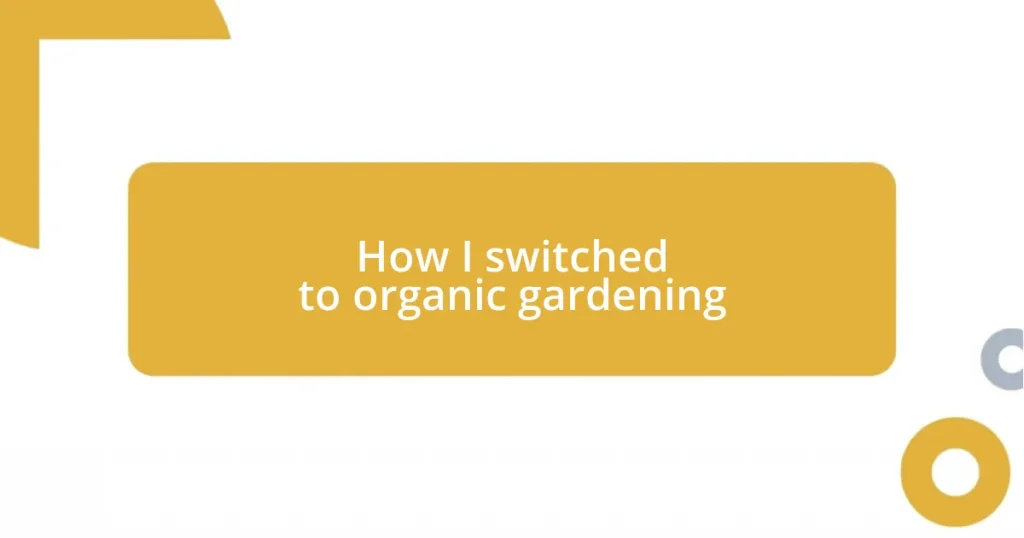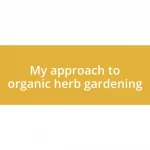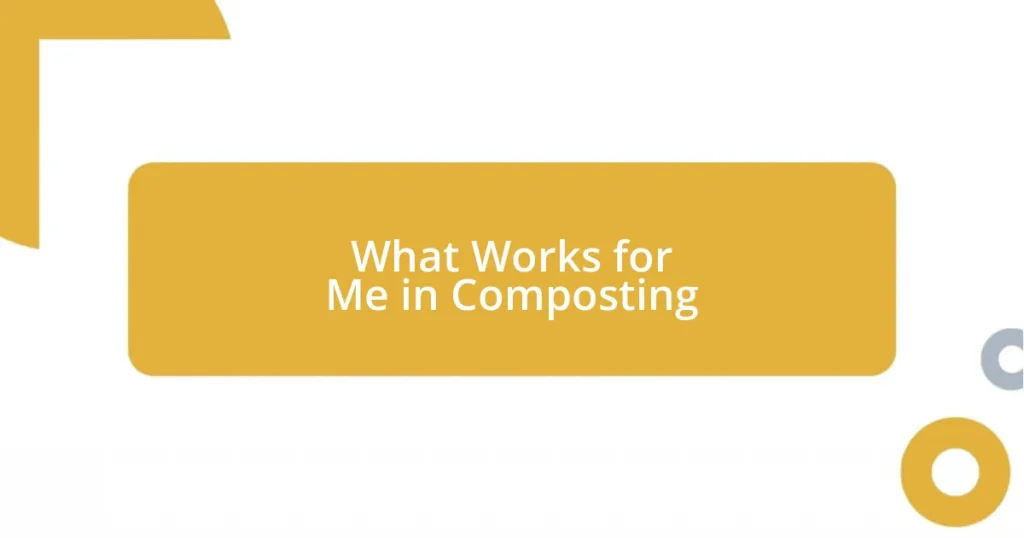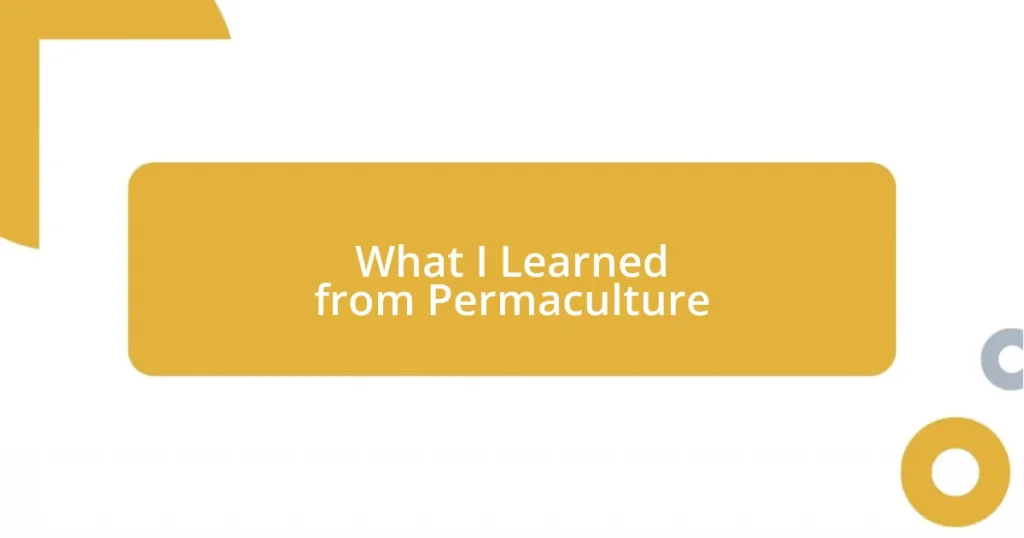Key takeaways:
- Building healthy soil through compost and organic matter is crucial for garden productivity.
- Diversity in planting enhances ecosystem balance and pest control, making the garden more resilient.
- Natural pest control methods, such as companion planting and homemade remedies, empower gardeners to manage their gardens effectively.
- Consistent maintenance, including regular monitoring and weeding, leads to a healthier and more thriving organic garden.

Understanding organic gardening principles
One of the core principles of organic gardening is the emphasis on building healthy soil. I remember when I first started, I was amazed by how much a good compost could transform my garden’s productivity. Just think about it: isn’t it incredible how a little bit of decomposed organic matter can bring such life back to the earth?
Another key principle is the importance of biodiversity. Introducing a variety of plants can create a balanced ecosystem that naturally controls pests. I once planted marigolds alongside my vegetables, and I was pleasantly surprised to find that not only did the marigolds thrive, but they also attracted beneficial insects that kept my garden thriving. It really made me ponder: how often do we overlook the beauty of a diverse garden?
Lastly, organic gardening advocates for minimal interference with natural processes. This principle resonated with me deeply when I decided to let my garden thrive on its own for a season. Seeing how nature self-regulated was eye-opening! Have you ever stopped to consider how much we can learn from simply observing nature? It’s a humbling experience to realize we’re just one part of a much larger system.

Evaluating your gardening space
To effectively evaluate your gardening space, take a moment to truly observe. I recall walking around my yard, pencil in hand, jotting down notes about sunlight, shade, and existing plants. Just standing there made me realize how different sections of my yard received varying amounts of light throughout the day. This simple act of observation not only informed my planting choices but also excited me about the potential growing possibilities.
When assessing your space, consider these key factors:
- Sun Exposure: Determine which areas get full sun, partial shade, or full shade. This will guide what plants will thrive.
- Soil Quality: Test your soil’s pH and nutrient levels. Healthy soil is the foundation of a successful garden.
- Space Layout: Take into account existing structures like trees, fences, or buildings that may affect airflow and light.
- Water Access: Identify how accessible water is for irrigation, as this is crucial for maintaining healthy plants.
- Microclimates: Notice any unique climate conditions in different spots; for instance, does one area stay cooler or warmer than the surrounding ones?
As I became more aware of these factors, I found my enthusiasm for organic gardening deepening with each observation. It felt like I was building a relationship with my garden, one that was based on understanding and respect for its unique characteristics.

Choosing organic seeds and plants
Choosing the right organic seeds and plants is a crucial step in creating a successful garden. I still remember the excitement I felt when I first selected organic seeds at a local market—they felt like tiny promises of future growth, each packed with potential. It’s essential to look for seeds labeled as “certified organic,” as this guarantees they were grown without synthetic pesticides or fertilizers. Trust me, choosing seeds that adhere to organic standards can make a significant difference in the health and taste of your plants.
In addition to seeds, selecting the right plants is equally important. I once tried to grow a popular vegetable without considering its adaptability to my local climate. The plant struggled while neighboring varieties flourished effortlessly. This experience taught me the value of choosing plants suited for my environment. It not only makes gardening more enjoyable, but it also prevents heartache when you’re faced with wilting leaves or stunted growth. Have you ever felt that frustration? Understanding your local conditions can be a game-changer.
Lastly, I encourage you to connect with local gardeners or seek advice from gardening communities. The knowledge and experiences they’ve shared have enriched my own gardening journey. Discovering heirloom varieties or native plants through their recommendations has led me to some of my favorite crops, which not only yield abundantly but also create a sense of community in my garden. Trust me, engaging with others is like watering your garden with friendship—it helps you grow in ways you may never have anticipated.
| Organic Seeds | Conventional Seeds |
|---|---|
| Grown without synthetic chemicals | May contain synthetic chemicals |
| Supports biodiversity | Less focus on diversity |
| Higher nutritional value | Varies in quality |
| Promotes soil health | May degrade soil over time |

Implementing natural pest control methods
Implementing natural pest control methods turned out to be one of the most fulfilling aspects of my organic gardening journey. In my first season, I discovered that companion planting worked wonders. I remember joyfully placing marigolds alongside my tomato plants, and to my surprise, the vibrant flowers deterred aphids while also attracting beneficial insects like ladybugs. It was almost magical to see nature in action—who knew that flowers could be such powerful allies?
Another method I enjoy is introducing homemade remedies. One day, after a mild outbreak of aphids, I whipped up a simple soap solution using natural dish soap and water. As I sprayed my plants, I felt a sense of empowerment; I was taking an active role in the well-being of my garden, rather than feeling helpless against pests. Have you ever felt that shift from frustration to control? That’s the beauty of organic gardening—every challenge becomes an opportunity to learn and adapt.
Beyond these methods, I’ve found that encouraging a diverse ecosystem is essential. Setting up a small birdbath in my garden invited local birds, which helped manage the insect population naturally. The sight of birds fluttering about while I tended to my plants introduced a joyful energy to the space. It made me realize that organic gardening isn’t just about avoiding chemicals; it’s about fostering a harmonious environment where plants and wildlife thrive together. How enriching is it to witness the balance of nature right in your backyard? This approach has truly changed my gardening experience for the better.
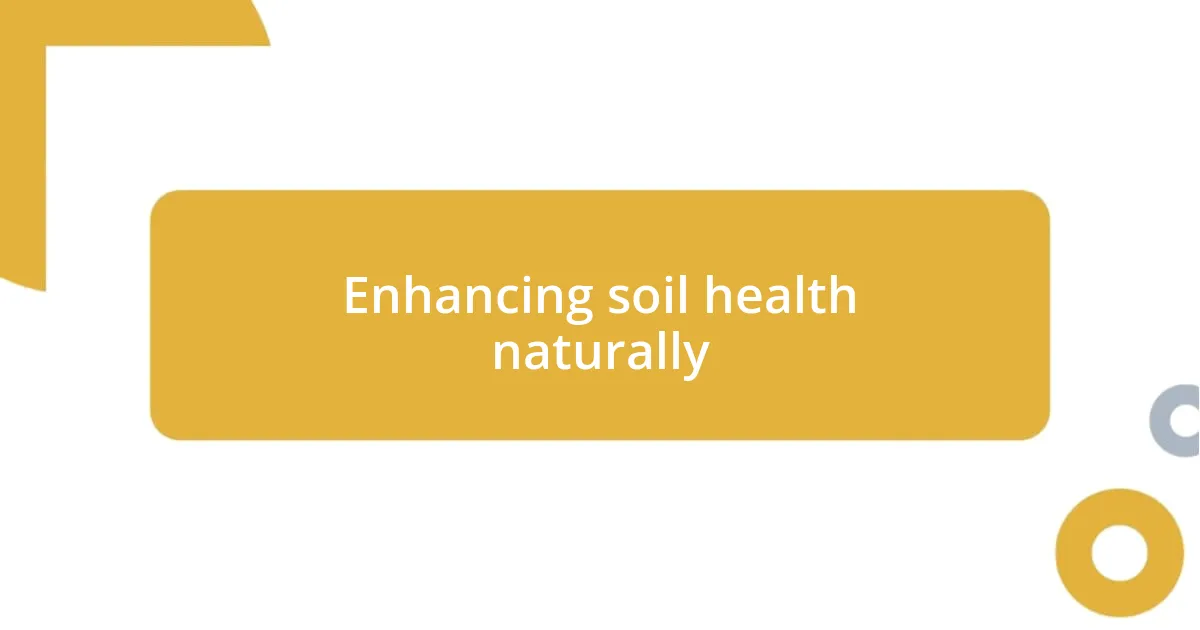
Enhancing soil health naturally
Soil health has always been a priority for me, and I discovered that enhancing it naturally is not only effective but also deeply fulfilling. One strategy that worked wonders in my garden was the incorporation of organic matter, like compost. I remember the first time I filled my raised beds with rich, dark compost. It felt like setting the foundation for a thriving community—there was an immediate boost in both the soil texture and moisture retention. Have you ever experienced the satisfaction of transforming something seemingly insignificant into a potent resource for growth?
Another approach I embraced was crop rotation. Initially, I was hesitant, thinking it would require more planning than I was comfortable with. But after trying it out, I was amazed at how my plants thrived. Rotating my leafy greens with legumes improved nitrogen levels in the soil, resulting in lush, robust plants. It was rewarding to see first-hand the benefits of working with nature rather than against it. Have you felt that delightful surprise when something you doubted turned into a revelation?
Lastly, I can’t stress enough the importance of mulching. When I first discovered mulch—oh, how my perspective changed! Spreading a layer of straw around my plants didn’t just suppress weeds; it provided a home for beneficial microorganisms. I vividly recall seeing earthworms weaving through the soil, and it filled me with such joy to know that my garden was becoming a vibrant ecosystem. Just think about how little actions, like applying mulch, can foster biodiversity in your own garden! It’s a small step with enormous benefits, and engaging in this process makes me feel more connected to my land.

Creating a sustainable watering system
Creating a sustainable watering system has been a pivotal part of my organic gardening experience. One summer, I faced a water shortage that pushed me to think creatively. I repurposed old rain barrels to collect water from my roof; it felt incredibly rewarding watching nature’s gift fill those barrels. Have you ever marveled at how rainwater is such a precious resource? The beauty of harnessing it made me appreciate every drop.
Incorporating drip irrigation was another game changer. I remember setting up the system on a particularly hot day, and the ease of watering directly at the roots was a revelation. Watching my plants flourish made me realize how efficient this method is for conserving water while delivering exactly what my garden needs. It’s interesting to think about how much we often waste when we simply use a hose. Have you found ways to make your watering routines more efficient?
Lastly, I’ve embraced the concept of timing. Watering early in the morning or late in the afternoon has worked wonders for my garden’s overall health. Initially, I struggled with this shift, craving the convenience of midday watering. But once I made the change, I noticed a remarkable difference in my plants’ vitality. It’s like they rewarded my efforts by flourishing under the right conditions. How fulfilling it is to see your plants thrive when you adjust your approach! It’s these little discoveries that continually deepen my love for sustainable gardening.
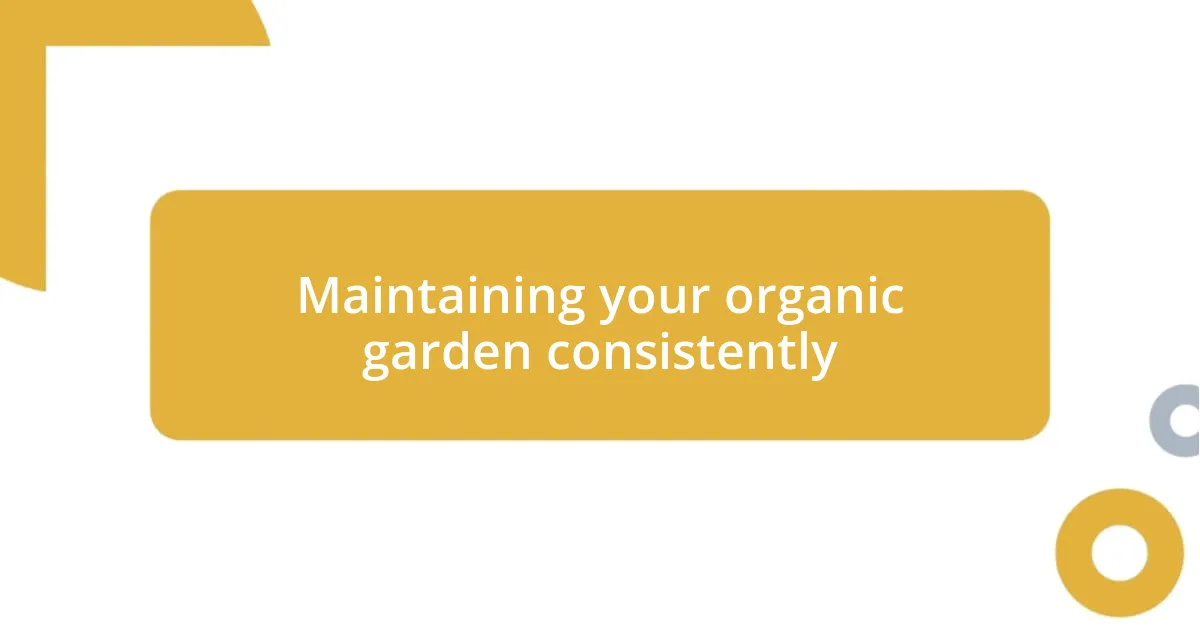
Maintaining your organic garden consistently
Consistently maintaining an organic garden feels like nurturing a living entity, and I’ve learned that regular monitoring is key. On several occasions, I’ve found myself wandering through my garden in the early morning, coffee in hand, simply observing the plants. This time spent outdoors not only grounds me but also allows me to catch any signs of distress—be it pests or wilting leaves—before they escalate. Have you ever taken a moment to simply be present in your garden? I find that these quiet observations often reveal what my plants need most.
Weeds are an ongoing challenge, but I’ve found that consistency in weeding truly pays off. At first, I was overwhelmed by the sheer volume of weeds, but I started dedicating just a few minutes each day to tackle them, and it changed everything. Each time I pulled a stubborn weed from the roots, I felt a surge of satisfaction mixed with the knowledge that I was protecting my plants’ precious resources. Isn’t it amazing how small, daily commitments can lead to a healthier garden?
Lastly, integrating regular feedings can significantly enhance my garden’s health. As I experimented with organic fertilizers, I remember the excitement of mixing my first batch of compost tea. Watching my plants respond to the nourishment felt rewarding, like nurturing friendships in the garden. Have you noticed how energy levels in plants can shift dramatically after a good feeding? It’s those moments of connection between effort and growth that truly light up my gardening journey.


